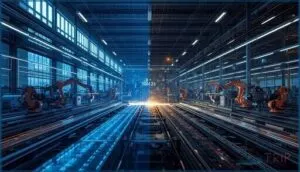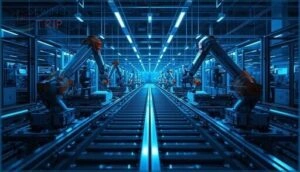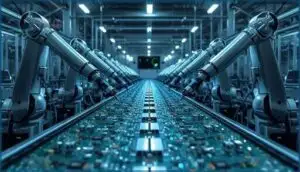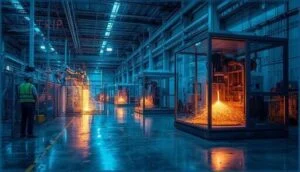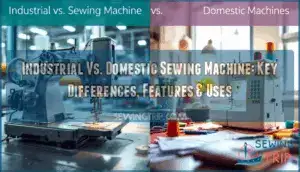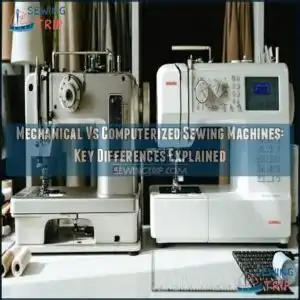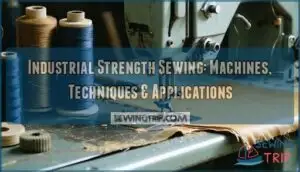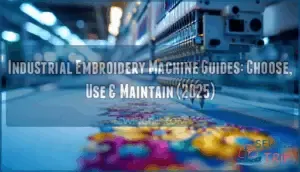This site is supported by our readers. We may earn a commission, at no cost to you, if you purchase through links.
Modern manufacturing floors have transformed into precision ecosystems where machines never clock out, errors vanish before they become defects, and production lines pivot in hours instead of weeks. The advantages of using industrial machines extend far beyond replacing manual labor—they’re reshaping how manufacturers compete, innovate, and deliver consistent quality at scale.
Automated systems now slash defect rates by half while driving productivity gains that manual processes can’t match, turning raw materials into finished products with accuracy that approaches ideal. Whether you’re evaluating automation investments or optimizing existing operations, understanding these concrete benefits reveals why industrial machinery has become the cornerstone of competitive manufacturing.
From 24/7 operational capability to real-time quality control that catches issues before they compound, the strategic edge these systems provide separates industry leaders from those struggling to keep pace.
Table Of Contents
Key Takeaways
- Industrial machines deliver measurable performance gains, including 24/7 operation at over 90% availability, up to 60% faster manufacturing speeds, and defect rate reductions of 50% through real-time quality control and automated precision that manual processes can’t match.
- Automation transforms cost structures by cutting direct labor expenses up to 40%, reducing material waste by 30%, and delivering payback periods of 1-3 years with annual ROI gains of 10-12% from combined efficiency improvements.
- Workplace safety improves dramatically as machines handle hazardous environments and repetitive tasks, reducing injury rates by roughly 1.2 cases per 100 workers and cutting repetitive strain incidents that previously accounted for 476,700 annual cases in U.S. manufacturing.
- Manufacturing agility becomes a competitive weapon through modular systems that enable 30-40% capacity expansion without full line replacement, 24-hour reconfiguration capabilities, and 35% faster product launch cycles that let you respond to market shifts in hours instead of weeks.
Increased Productivity and Efficiency
When you’re looking to transform your manufacturing operations, productivity and efficiency are where the real magic happens. Industrial machines don’t just work faster—they fundamentally change how you compete in today’s market.
Let’s explore the key ways automation unlocks extraordinary levels of output and operational performance.
24/7 Continuous Operation
Industrial machines enable truly game-changing Uptime Optimization by running around the clock, letting you achieve over 90% availability. This continuous operation supercharges Increased Productivity Levels and production efficiency, spreading fixed costs across greater output while supporting just-in-time manufacturing.
Remote Monitoring and Predictive Analytics enable fluid Shift Management and automation, optimizing Energy Efficiency and Operational efficiency without the costly downtime that kills your competitive edge. This is largely due to the implementation of automation technologies, which are becoming increasingly common.
Faster Manufacturing Speeds
Beyond just running nonstop, automation supercharges Throughput Gains. You’ll see up to 60% higher output rates compared to manual lines. Industrial robots complete tasks 20 times faster than human operators, slashing Cycle Time by 35% in leading plants.
This Precision Speed maintains defect rates below 0.2% while Reduced Downtime keeps machines humming at over 90% utilization.
Automation also reduces operational costs through minimized labor and waste. Your Demand Response window shrinks to mere hours, transforming production efficiency.
Streamlined Workflow Management
Workflow optimization is key to eliminating operational headaches. 69% of managerial tasks now run fully automated, freeing you from constant oversight. Task coordination connects departments seamlessly, while bottleneck reduction keeps materials flowing. You’ll gain real-time monitoring that spots hiccups instantly, plus cross-functional integration that transforms siloed chaos into synchronized precision.
- Automated processes slash errors by 37% while boosting data integrity by 88%
- Manufacturing automation cuts bottlenecks through intelligent task routing and priority management
- Real-time dashboards reveal exactly where delays occur, enabling immediate corrective action
- Organized workflow management delivers 25-30% productivity improvement through coordinated execution
Scalability and Rapid Market Response
When demand fluctuations hit, your manufacturing agility determines survival. Modular automation permits 30-40% capacity expansion without replacing entire lines, while AI-driven systems boost throughput by 50% during market volatility. You’ll achieve faster time-to-market with 35% reduced launch cycles, responding to supply adaptation challenges with precision.
| Scalability Factor | Performance Impact | Market Response Speed |
|---|---|---|
| Modular Production | 30-40% capacity increase | 24-hour reconfiguration |
| AI Automation | 50% throughput boost | Real-time demand matching |
| Agile Manufacturing | 25% faster market entry | 40% quicker schedule adjustments |
Production scaling transforms reactive operations into proactive competitive weapons.
Enhanced Product Quality and Consistency
When your manufacturing process is inconsistent, you’re leaving quality up to chance. Industrial machines eliminate the guesswork by delivering precision that human hands simply can’t replicate at scale.
Here’s how automation transforms product quality from variable to virtually perfect.
Improved Quality Control
When you shift to machine-based quality control, you’re tapping into a level of precision manual inspection can’t match. Real-time monitoring systems can slash defect rates by up to 50%, while automated machine vision detects and classifies product defects with over 98% accuracy.
Statistical control techniques enable continuous improvement, helping you achieve production consistency and traceability compliance that strengthens both your manufacturing processes and competitive edge.
Reduced Human Error
Because human error causes roughly 80% of manufacturing defects, automation delivers a sweeping advantage—reducing those errors by up to 90%. AI-driven solutions and real-time detection systems eliminate fatigue-related mistakes, while process redesign and training effectiveness further strengthen error source analysis.
Automation slashes manufacturing defects by up to 90% by eliminating the human error that causes 80% of quality failures
You’ll see enhanced product quality and cost reduction, with the advantages of industrial robots reflected in precision that human operators simply can’t sustain consistently.
Real-Time Data and Analytics
When you integrate real-time data and analytics into your manufacturing operations, you create continuous quality control, bottleneck identification, and predictative maintenance that drive data-driven decision making.
Real-time data fosters operational agility—sensors detect deviations instantly, triggering corrective actions before defects escalate.
This data analysis approach reduces downtime by up to 20% while ensuring every product meets your standards consistently.
Traceability in Production
Traceability in production transforms your manufacturing process into a transparent, fully accountable system. You can track every component through each stage, linking defects to specific machines, materials, or timeframes.
This root cause analysis capability drives continuous improvement while strengthening quality control across your supply chain.
Data integration facilitates up to 20% gains in operational efficiency through faster problem resolution, reduced waste, and the proactive decision-making that industrial automation demands.
Lower Operational and Labor Costs
When you invest in industrial automation, you’re not just upgrading your equipment—you’re fundamentally reshaping your cost structure. The financial benefits extend far beyond replacing manual labor, touching everything from how you use materials to how you maintain your machines.
Let’s look at four ways automation can transform your bottom line.
Reduced Direct Labor Expenses
When you deploy industrial machines strategically, you can cut your labor costs by up to 40% while strengthening your operational foundation. The Automation ROI becomes evident through:
- Cost Per Unit drops by approximately 25% after implementing machinery
- Long-Term Savings emerge as automation proves 50% more economical than manual labor over ten years
- Administrative labor decreases 15-25% through automated scheduling systems
- Skilled Labor Shift occurs as you retrain workers for oversight roles rather than repetitive tasks
- Workforce Retraining investments improve productivity while maintaining employment
This cost reduction in manufacturing transforms your competitive position without sacrificing your workforce’s potential.
Efficient Resource Utilization
Industrial machines transform resource utilization into a competitive weapon. You’ll achieve machine utilization rates of 85-90%, while AI applications improve material flows and cut waste by up to 30%.
Energy-efficient processes dynamically adjust consumption, and automated workflow integration eliminates bottlenecks.
This efficiency directly boosts your ROI—production costs drop 20-30% through improved material use and reduced energy expenditure per unit.
Predictive Maintenance Strategies
Predictive maintenance strategies let you spot equipment failures before they happen, cutting unplanned downtime by 30-50% and extending equipment lifespan by 20-40%. You’ll save 18-25% on maintenance costs through IoT-driven equipment monitoring systems that track system performance in real time.
This proactive approach delivers cost savings of $30,000 annually on parts alone while reducing safety risks by 14%, creating a powerful foundation for market growth.
Return on Investment in Automation
Beyond cutting costs, you’ll want to know when your automation investment pays for itself. The payback period generally falls between 1 and 3 years, with positive ROI emerging by year two.
- Cost savings from reduced labor and waste often exceed initial investments annually
- Quality improvements and increased productivity drive 10-12% efficiency gains
- Scalability benefits enable rapid market response without proportional cost increases
The financial impact? Measurable millions in annual returns.
Improved Workplace Safety
When you shift repetitive or dangerous tasks to industrial machines, you’re not just boosting efficiency—you’re protecting the people who keep your operation running. Automated systems step in where human workers face the highest risk of injury or chronic strain, creating a safer environment from the ground up.
Here’s how automation transforms workplace safety in manufacturing.
Minimizing Repetitive Task Injuries
Repetitive functions that require bending, twisting, and lifting drive up employee injuries—and the numbers prove it. In 2015 alone, repetitive strain injuries accounted for 476,700 nonfatal cases in U.S. manufacturing. Automation slashes this burden by handling tasks that wear down your workforce, reducing annual injury rates by roughly 1.2 cases per 100 workers. Real-time monitoring and safety barriers on machines keep operators out of harm’s way, while ergonomic workstations designed into automated systems lower the physical toll.
The payoff goes beyond workplace safety. Fewer injuries mean lower injury costs—think reduced workers’ comp claims, less downtime, and fewer expensive turnover cycles. You’ll also see morale improvement as your team shifts from grueling manual labor to supervisory and technical roles that actually engage their skills. Intelligent lifting devices and programmable automation limit forceful motions to ergonomically safe ranges, protecting your people from the fatigue that leads to mistakes and time off.
| Impact Area | Before Automation | After Automation |
|---|---|---|
| Injury Rate (per 100 workers) | 3+ cases annually | ~1.8 cases annually |
| Annual U.S. Injury Cost | $163.9 billion total | Markedly reduced per facility |
| Worker Fatigue Level | High from repetitive strain | Minimized through machine handling |
| Compliance with Safety Standards | Manual enforcement challenges | Enhanced through built-in features |
| Employee Focus | Repetitive physical tasks | Supervisory and technical work |
Enhancing workplace safety isn’t just about ticking regulatory boxes—it’s about building a resilient operation where your workforce stays healthy, engaged, and productive.
Reducing Exposure to Hazardous Environments
Machines excel at handling tasks where toxic fume reduction, confined space safety, and chemical exposure control matter most. You’ll protect your workforce by deploying robots in extreme heat, molten metal zones, and toxic atmospheres—environments that would otherwise demand protective gear and constant health monitoring.
- Automated fluid dispensing shields operators from corrosive chemicals and harmful vapors
- Robotic welding cells eliminate direct exposure to metal fumes and ultraviolet radiation
- Programmable material handlers operate in oxygen-deficient or gas-filled confined spaces
- Enclosed grinding systems contain abrasive dust, preventing respiratory illness
- Emergency response automation detects leaks and triggers containment before human exposure
Long-term health improvements follow naturally. Studies confirm that integrating engineering controls with robotics cuts chemical-related injuries and chronic conditions—your team avoids prolonged contact with substances that cause lasting damage.
Improving workplace safety through automation isn’t just about today’s incident reports; it’s about protecting your people from illnesses that surface years down the line.
Enhancing Compliance With Safety Standards
When you deploy industrial automation, you’re not just gaining efficiency—you’re building a foundation for OSHA compliance and risk assessment that protects your operation from costly violations. Automated machine guarding and documented safety training programs reduce incident rates by over 50%, while real-time monitoring ensures adherence to ANSI and ISO standards.
These safety improvements translate directly into fewer injuries, lower legal exposure, and sustainable workplace safety that bolsters long-term competitiveness.
Real-Time Equipment Monitoring
Catching equipment faults the instant they occur gives you a powerful advantage: real-time monitoring cuts unplanned failures by 30% and slashes injury rates up to 40%. Predictive maintenance driven by continuous data analytics extends asset utilization while reducing workplace incidents by over 30%.
You’ll make data-driven decisions faster, preventing hazards before they escalate and keeping your operation safer through intelligent fault detection.
Flexibility and Competitive Advantage
In today’s fast-moving market, your ability to pivot quickly can make or break your competitive position. Industrial automation gives you the agility to respond to demand shifts, integrate modern technology, and align with sustainability expectations that customers increasingly value.
Let’s look at how these machines position your operation to stay ahead of the competition.
Quick Adaptation to Market Changes
When markets shift unexpectedly, flexible automation lets you pivot production without massive delays. Modular design and real-time data enable faster time to market, with some plants cutting new product launches from a year to just six months.
You’ll handle supply disruptions, regulatory shifts, and batch flexibility more effectively, giving your operation the scalability and agility needed to outpace competitors and seize emerging opportunities quickly.
Integration With Smart Manufacturing Systems
Connecting your industrial automation to smart manufacturing systems transforms raw data into strategic power. IIoT connectivity lets you monitor production floor-to-boardroom, while data integration across ERP, MES, and machine sensors delivers real-time optimization that cuts downtime by half.
Smart dashboards give you instant visibility, system interoperability enables agile reconfiguration, and real-time data and analytics drive digital transformation—fueling the competitive edge you need today.
Supporting Sustainability Goals
You can’t ignore sustainability goals when machinery innovations are driving 5–11% reductions in industrial energy consumption. Automated systems provide environmental performance that transforms your competitive edge while meeting regulatory demands.
- Energy Efficiency and Emission Reduction: Variable frequency drives cut motor energy use by 30–50%, while predictive maintenance slashes unnecessary emissions.
- Resource Optimization: Automation reduces scrap rates from 24% down to 1.8% through precise material handling.
- Lifecycle Extension: Smart thermal management and real-time monitoring double equipment lifespan, advancing sustainable manufacturing practices across your supply chains.
Gaining an Edge in Global Markets
Your export competitiveness accelerates when sophisticated machinery drives a 34% faster response to international market shifts and facilitates flexible customization. Asia-Pacific’s 8.5% CAGR demonstrates how automation builds global positioning through productivity enhancement. Industry 4.0 adoption by 44% of manufacturers strengthens market agility, while optimizing production processes delivers a 15–25% ROI over three years, transforming manufacturing efficiency into a sustainable competitive advantage in global markets.
| Capability | Market Impact |
|---|---|
| Rapid scaling of output | Up to 45% capacity increase during export surges |
| Predictive analytics integration | 28% faster order turnaround for global customers |
| Flexible product customization | 63% of exporters report growth in specialized markets |
Frequently Asked Questions (FAQs)
What are the initial costs of industrial automation?
Your initial investment generally ranges from $150,000 to $500,000 for complete automation systems.
Robot unit costs, system integration, software expenses, installation costs, and facility upgrades all contribute to determining your total upfront capital requirement and eventual ROI.
How do machines impact traditional craftsmanship and skills?
Like scrolls yielding to presses, machines displace artisan skills—hand weaving, embroidery fade. Yet digital integration offers hybrid paths.
This cultural heritage loss trades customization for speed, revealing technology’s double-edged economic impact on craftsmanship.
What environmental concerns does industrial machinery create?
Industrial machinery contributes to air pollution, water contamination, and waste generation, while depleting natural resources. Noise pollution and environmental degradation persist without eco-friendly practices.
Achieving environmental sustainability demands real-time monitoring and smarter, cleaner operational strategies.
How does automation affect workforce employment and displacement?
You might be surprised to learn that while 2 million U.S. jobs face displacement from automation, the technology simultaneously creates pathways for 133 million new roles globally—transforming rather than simply eliminating work.
What expertise is needed for robot maintenance?
You’ll need technical proficiency in mechanical repairs, software troubleshooting, and equipment monitoring.
Safety compliance and certification standards are essential, especially for predictive maintenance and preventive maintenance strategies that improve industrial robot performance.
Conclusion
Sure, you could keep running your operation like it’s 1985—manually tracking defects, losing sleep over downtime, and watching competitors sprint past while you’re still lacing up. Or you could tap into the advantages of using industrial machines to transform your floor into a precision powerhouse.
The choice isn’t whether to automate anymore; it’s whether you’re ready to lead your market or become a cautionary tale in someone else’s case study.
- https://www.google.com/search?q=xtremeautomationllc&rlz=1C1CHBF_enPK1149PK1149&oq=xtremeautomationllc&gs_lcrp=EgZjaHJvbWUyBggAEEUYOTIGCAEQRRg8Mg8IAhAuGA0YrwEYxwEYgAQyDQgDEAAYhgMYgAQYigUyBggEEEUYPDIGCAUQRRg8MgYIBhBFGDwyBggHEEUYPNIBCDI3MzhqMGo0qAIAsAIB8QV1-hyc93QKLg&sourceid=chrome&ie=UTF-8
- https://i0.wp.com/rbtautomate.com/wp-content/uploads/2022/08/11-Benefits-of-an-Industrial-Automation-System-scaled.jpg?fit=2560%2C1435&ssl=1
- https://www.haumiller.com/blog/high-speed-automation-benefits
- https://www.qualitymag.com/articles/96089-three-manufacturing-trends-that-meet-the-need-for-speed
- https://ieeexplore.ieee.org/document/10725011/


